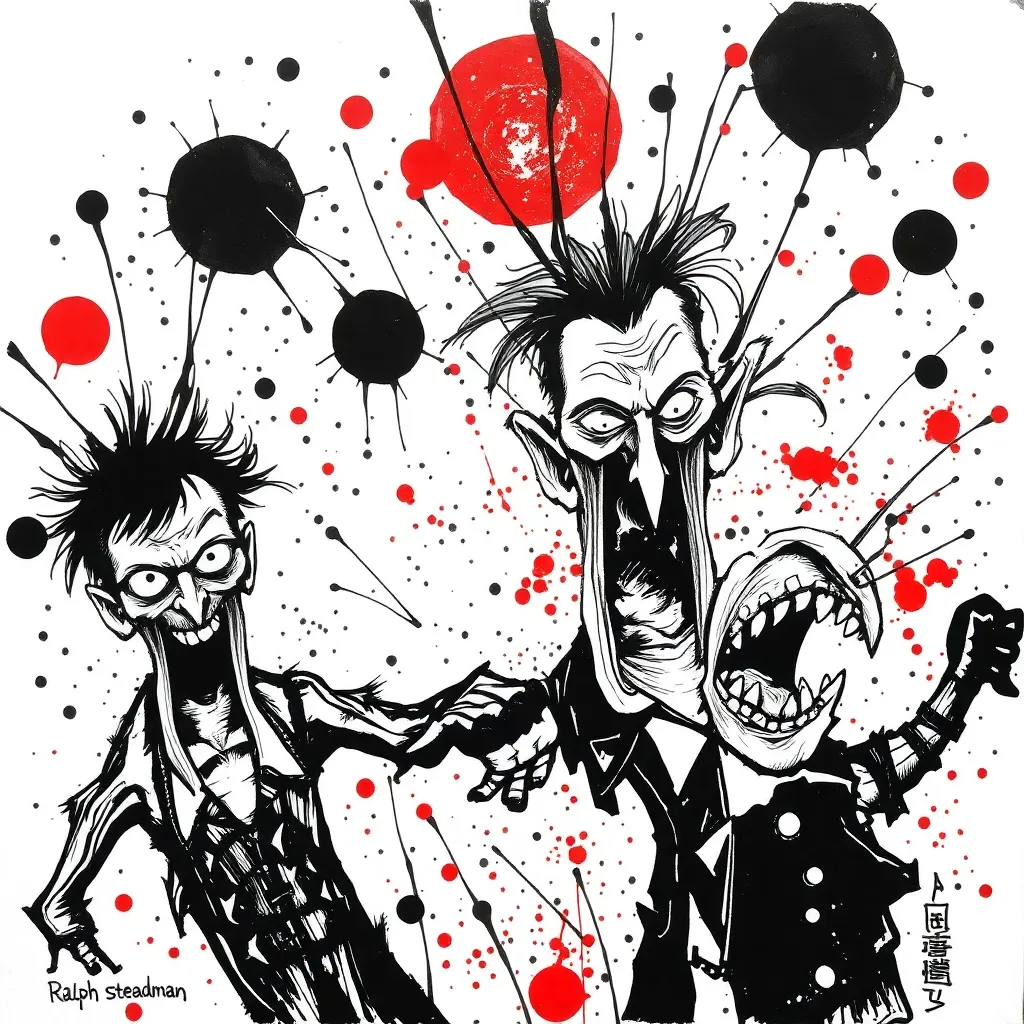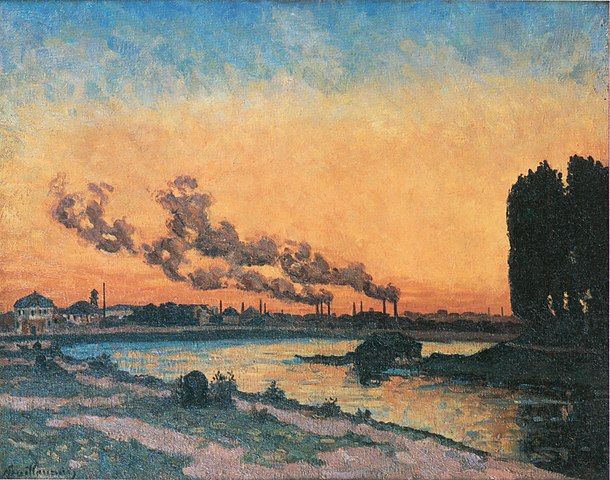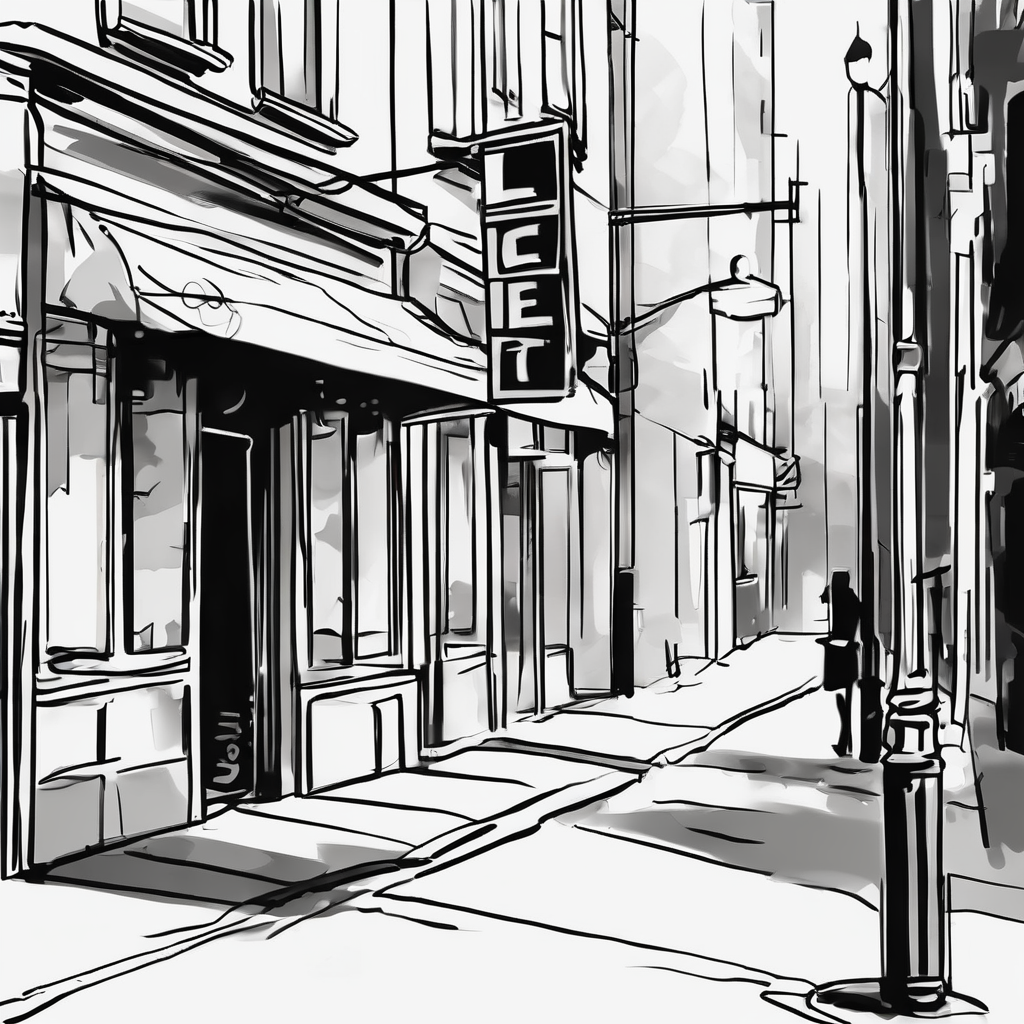Caricature art is where imagination meets reality in the most entertaining way possible. Famous caricature artists have mastered the art of exaggerating a person’s most distinctive features while still keeping them recognizable – bigger noses, wider smiles, or more prominent chins! These talented artists don’t just draw funny pictures; they tell stories, make political statements, and help us see the world through a different lens. From historical masters who used their art to criticize rulers to modern digital artists who delight us with celebrity portraits, caricature artists have shaped our visual culture in profound ways.
Key Points:
- Caricature art exaggerates distinctive features while maintaining recognizability
- Famous caricature artists span centuries, from 18th century political satirists to modern digital creators
- Studying these masters can improve your own artistic skills
- Each artist developed unique techniques that revolutionized the art form
- Caricatures serve as both entertainment and powerful social commentary
Create Your Own Digital Caricature
Transform a simple face into a stylized masterpiece with our Caricature Maker! This interactive tool lets you adjust facial features with easy-to-use sliders, creating unique caricatures inspired by legendary artists like
Caricature Maker
What Makes Caricature Artists Famous?
What transforms a regular artist into one of the famous caricature artists we study today? It’s a special blend of skills: keen observation, technical ability, and a unique perspective that helps them capture not just how someone looks, but who they are. The best caricaturists don’t just exaggerate random features—they identify what makes each face unique and highlight those elements to reveal personality and character.
Great caricature art makes us laugh while also making us think. Whether through political commentary, celebrity satire, or cultural criticism, these artists use humor and exaggeration to convey deeper truths. Let’s explore the masters who perfected this challenging art form and learn what makes their work so special.
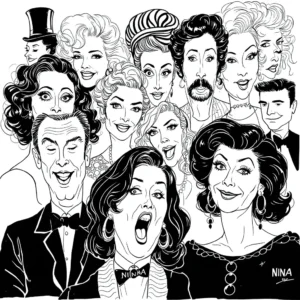
1. Al Hirschfeld – Master of the Line
Al Hirschfeld (1903-2003) transformed Broadway with his elegant black and white line drawings. What made Hirschfeld special was his ability to capture a performer’s essence with just a few perfectly placed lines. Broadway stars considered it a badge of honor to be “Hirschfelded,” and his work appeared in The New York Times for over 75 years!
Hirschfeld’s signature move was hiding his daughter’s name “NINA” within the lines of his drawings—sometimes dozens of times. This playful “Where’s Waldo” aspect made his caricatures even more engaging for readers who would count how many “NINAs” they could find.
“My contribution is to take the character—created by the playwright and acted by the actor—and reinvent it for the reader.”
Al Hirschfeld
His minimalist style proves that sometimes less is more in caricature art. By focusing on just the most important lines, Hirschfeld created instantly recognizable portraits that captured not just appearance but energy and movement.
2. James Gillray – The Father of Political Caricature
Long before political cartoons filled our newspapers, James Gillray (1756-1815) was using satirical portraits to comment on 18th-century British politics. His colorful etchings featuring exaggerated politicians weren’t just funny—they were powerful tools for criticizing the powerful in an era when direct criticism could be dangerous.
Gillray’s caricatures of King George III, Napoleon Bonaparte, and other political figures of his time were so influential that they actually shaped public opinion and affected political outcomes. His work reminds us that humorous portrait caricatures have serious power.
His detailed, colorful style contrasts with Hirschfeld’s minimalism, showing that caricature art can take many forms while still capturing essence through exaggeration.
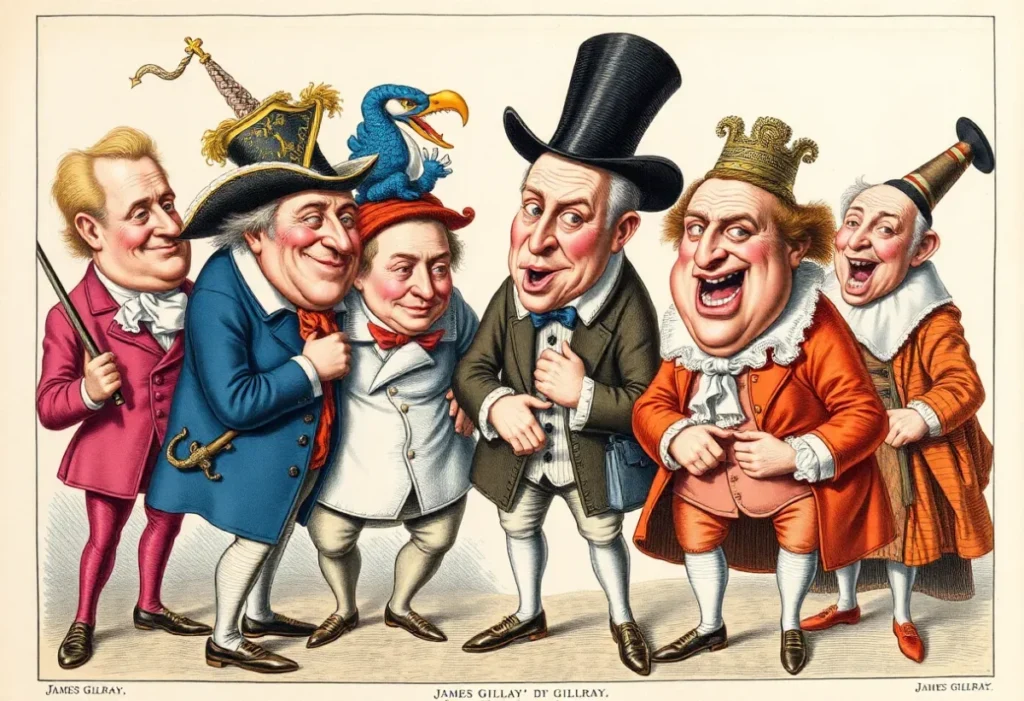
3. Honoré Daumier – The Champion of the Common People
Honoré Daumier (1808-1879) used his caricature skills to stand up for everyday people against the French government and upper classes. His satirical illustrations in the magazine La Caricature were so powerful that he was actually imprisoned for six months for depicting King Louis-Philippe as a greedy monster!
What makes Daumier’s work stand out is how he combined exaggerated facial features with realistic body language to create characters that feel deeply human despite their distorted appearance. His work shows how caricature art can be a powerful tool for social justice and giving voice to the voiceless.
4. Thomas Nast – America’s First Great Caricaturist
Thomas Nast (1840-1902) might be the most influential American political caricaturist ever. He created our modern image of Santa Claus and gave us both the Republican elephant and Democratic donkey symbols! His greatest achievement was using his caricatures to help bring down the corrupt Tweed Ring that controlled New York City politics.
Nast’s detailed cross-hatching technique created rich, textured caricatures that jumped off the page. His work demonstrates how exaggerated portrait art can drive real political change when it connects with people emotionally.
5. Sebastian Kruger – Hyperrealistic Exaggeration
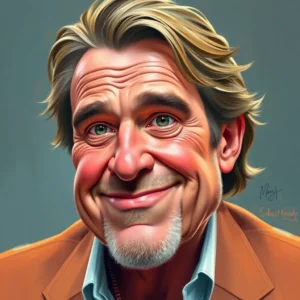
Moving to more contemporary famous caricature artists, Sebastian Kruger (born 1963) represents a stunning evolution of the form. His photorealistic paintings of celebrities like Mick Jagger and Jack Nicholson are both technically impressive and wildly exaggerated.
What makes Kruger’s work fascinating is the contrast between his extremely realistic painting technique and the impossible proportions of his subjects. His caricatures look like photographs from an alternate reality where famous faces have been stretched and reshaped while somehow remaining instantly recognizable.
Famous Caricature Artists of the Modern Era
The 20th century saw an explosion of caricature styles as mass media provided new platforms for these artists to share their work. Magazine illustrations, album covers, and newspaper editorial sections became showcases for caricature masters.
6. Ralph Steadman – Chaotic Genius
Ralph Steadman (born 1936) revolutionized caricature with his splattered ink technique that feels like controlled chaos. Best known for his illustrations of Hunter S. Thompson’s “Fear and Loathing in Las Vegas,” Steadman’s angry, energetic style perfectly captured the madness of 1970s counterculture.

Steadman’s technique involves deliberately losing some control over his materials, allowing ink to splatter and spread in unpredictable ways. This approach creates caricatures that feel alive with manic energy and emotion, proving that caricature art isn’t just about careful precision.
7. Mort Drucker – The MAD Magazine Legend
If you’ve ever laughed at a movie parody in MAD Magazine, you’ve probably enjoyed Mort Drucker’s (1929-2020) incredible caricatures. For over five decades, Drucker created detailed, multi-character scenes that parodied popular movies and TV shows with uncanny accuracy.
What made Drucker special was his ability to draw anyone—from any angle—while keeping them instantly recognizable. His detailed cross-hatching technique created depth and dimension that made his caricatures feel three-dimensional. Directors like George Lucas and Steven Spielberg collected his parodies of their films, recognizing his unique talent.
Visit our guide to understanding cross-hatching techniques to learn more about this important skill used by many famous caricaturists.
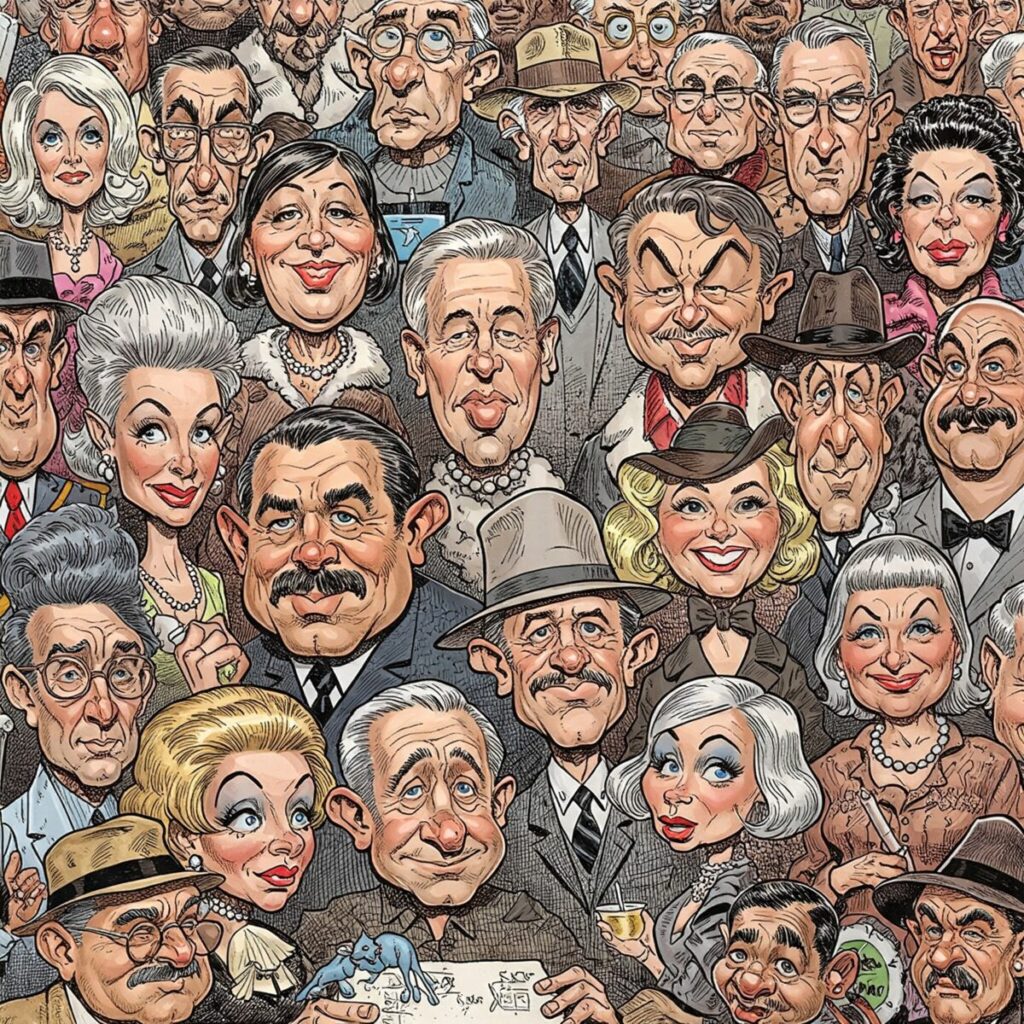
8. Gerald Scarfe – Savage Beauty
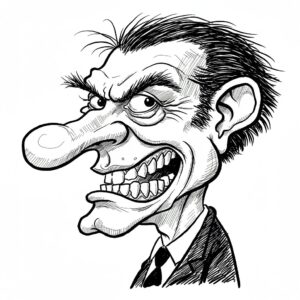
Gerald Scarfe (born 1936) created some of the most biting political caricatures of the late 20th century. His distorted, fluid style—where faces seem to melt and stretch—perfectly conveys the corruption and moral flexibility of his political targets. Beyond politics, many people know his work from Pink Floyd’s “The Wall” album and film.
Scarfe’s aggressive style shows how caricature art can express powerful emotions like anger and disgust through exaggeration. His work proves that beautiful art can be deliberately ugly when it serves a purpose.
9. Jack Davis – Versatile Master
Jack Davis (1924-2016) could do it all—from horror comics to movie posters to magazine covers to advertising. His energetic style featured exaggerated limbs, distinctive faces, and an unmistakable loose, sketchy quality that conveyed movement and life.
Davis’s versatility shows how caricature skills can be applied across many different types of commercial art. His successful career demonstrates that mastering humorous portraiture can open doors to varied artistic opportunities.
Looking to explore different artistic styles? Check out our comprehensive guide to famous painting styles to see how caricature relates to other art forms.
10. Jan Op De Beeck – Modern Innovation
Jan Op De Beeck (born 1958) represents the continuing evolution of caricature art in the digital age. This Belgian artist combines traditional drawing skills with digital tools to create stunning portraits that feel both classic and contemporary.
Op De Beeck’s work shows how modern caricaturists can blend traditional techniques with new technology. His digital caricatures maintain the human touch that makes great caricature art connect emotionally while embracing new possibilities.
Comparing Caricature Styles
| Artist | Era | Primary Medium | Distinctive Style |
|---|---|---|---|
| Al Hirschfeld | 20th Century | Ink on paper | Minimalist line art |
| James Gillray | 18th/19th Century | Hand-colored etchings | Detailed political satire |
| Honoré Daumier | 19th Century | Lithography | Social realism with exaggeration |
| Thomas Nast | 19th Century | Wood engravings | Detailed political symbolism |
| Sebastian Kruger | Contemporary | Acrylic paint | Hyperrealistic distortion |
| Ralph Steadman | Contemporary | Ink splatter | Chaotic, energetic distortion |
| Mort Drucker | 20th Century | Pen and ink | Detailed cross-hatching |
| Gerald Scarfe | Contemporary | Watercolor/ink | Fluid, melting distortion |
| Jack Davis | 20th Century | Pen and ink | Energetic, sketchy style |
| Jan Op De Beeck | Contemporary | Digital/traditional | Blended techniques |
Learning from the Masters
Studying these famous caricature artists offers valuable lessons for anyone interested in portraiture or character design. Each artist developed unique approaches to the fundamental challenge of caricature: how to exaggerate while maintaining recognizability.
For painters interested in portraiture, explore our article on portrait painting techniques to see how caricature principles can inform more traditional portrait approaches.
Here’s a helpful YouTube tutorial on basic caricature techniques that builds on principles used by the masters:
Why Caricature Art Matters
Beyond entertainment, caricature art serves important cultural functions. Throughout history, it has been a tool for:
- Speaking truth to power when direct criticism was dangerous
- Making complex political situations understandable through visual metaphor
- Revealing the hidden character or motivations of public figures
- Providing social commentary in an accessible, humorous format
- Pushing the boundaries of how we represent human features in art
For artists looking to incorporate elements of caricature into more traditional artwork, check out our guide on mixing artistic styles for inspiration.
Conclusion
From the political etchings of James Gillray to the hyperrealistic paintings of Sebastian Kruger, famous caricature artists have continuously reinvented this special art form. Each generation builds on the techniques of previous masters while adapting to new technologies and cultural contexts. Whether you’re interested in creating caricatures yourself or simply appreciating this unique art form, studying these ten influential artists provides insight into how exaggeration can reveal truth in ways realistic portraiture cannot.
The best caricature art makes us laugh while also making us think differently about its subjects. As you explore the work of these masters, pay attention to how they balance humor with insight, exaggeration with recognition. Their ability to distill complex personalities into powerful visual statements is what makes them not just good illustrators, but truly famous caricature artists whose work continues to influence visual culture today.
FAQ About Famous Caricature Artists
How is drawing a caricature different from drawing a regular portrait?
Caricature art emphasizes and exaggerates a person’s most distinctive features, while traditional portraiture aims for accurate representation. Caricaturists look for what makes a face unique and amplify those characteristics, creating a recognizable but distorted version that often reveals personality traits.
What software do professional digital caricature artists use?
Professional digital caricaturists commonly use programs like Procreate, Adobe Photoshop, and Corel Painter. Some traditional artists who have moved to digital work use specialized tablets like Wacom Cintiq that allow them to draw directly on a screen for better hand-eye coordination.
Can I learn caricature drawing if I’m not naturally talented at art?
Absolutely! Caricature drawing is a skill that can be learned through practice. It actually helps to start by understanding basic proportions of the human face, then learning to identify and exaggerate distinctive features. Many successful caricaturists developed their skills through consistent practice rather than innate talent.
What’s the difference between a cartoon and a caricature?
While both may be stylized drawings, a cartoon typically presents fictional characters in simplified form, whereas a caricature specifically exaggerates the features of a real person while maintaining their recognizability. Caricatures aim to capture essence and personality through strategic exaggeration of actual people.
Where can I see exhibitions of famous caricature artists’ work?
The Society of Illustrators in New York often features caricature exhibitions, as does the National Portrait Gallery in Washington, DC. For international work, the Wilhelm Busch Museum in Hannover, Germany specializes in caricature and cartoon art. Many famous caricaturists also have permanent collections in major art museums worldwide.

